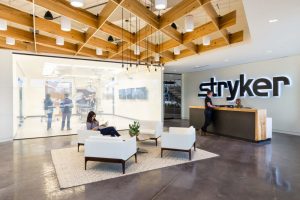Off the back of a successful 2019, Stryker, the Fortune 500 medical technologies firm based in Kalamazoo, Michigan has a lot of momentum and healthy prospects in 2020.
The company has near doubled its revenue to about $15 billion ever since Kevin Lobo joined Stryker as CEO in 2012. Touted as one of the best med-tech companies, Stryker has a winning combination of growth, organic growth, and margin power that gives it a premium valuation. So what is the company’s secret? Combining the benefits of a culture of innovation with an aggressive growth strategy.
The company, which manufactures everything from cranial implants to inflatable heel boots, looks for acquisitions that “fit right into an existing business,” said Lobo. “We want to bolster and strengthen our position wherever we play. We want to be absolute leaders in the field.”
The company’s recent acquisition of Canadian sterilization technology innovator, TSO3 for $52 million is a prime example of this. Stryker is valued at over $85 billion, making this buyout barely significant, however, the low-risk acquisition is serious business for hospital customers and represents an easy win.
Though, Stryker has a penchant for risks. Its recent $5.4 billion acquisition of Wright Medical caught the attention of the Federal Trade Commission. An SEC filing on January 2 showed that the FTC is upping its scrutiny of the proposed merger that may have anticompetitive consequences. Despite the risk, this deal makes sense in terms of building Stryker’s long-term growth potential.
During the Chief Executive's Healthcare CEO Summit earlier in the month, Lobo expressed that he actually values low-risk buys. “I’d rather pay more money for something that works,” he said. The company has shown a history of scooping up small innovative companies and leveraging their expertise for lower costs. Although the CEO has strong ideas about the company’s direction, he stresses the importance of functional autonomy for each division of the company. “It’s a culture of being driven, focused on sales growth that’s focused on your customer,” he says.
While acquisitions appear to be Stryker’s bread and butter, they also invest 6.5% of revenue into research and development— “if you don’t have [that], how can you assess what’s a good technology and what’s not?” Lobo remarked.























